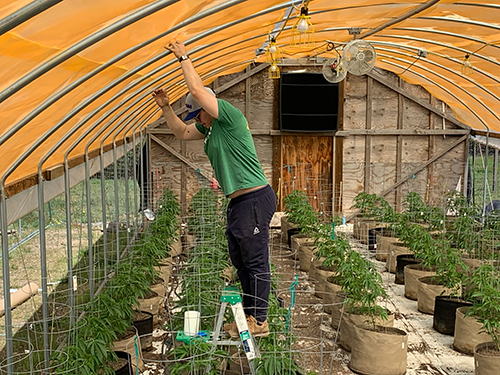UbiGro helps growers boost crop yields by providing the best sunlight environment – more orange and red light for enhanced crop growth – without using electricity. UbiGro is a passive solar product.
 Photosynthetically Efficient Colors for Crop Growth and Biomass Accumulation
Photosynthetically Efficient Colors for Crop Growth and Biomass Accumulation

Q&A with Dr. Damon Hebert,Head of Marketing | UbiQD, Inc.
Tell us about UbiQD and your role with the company.
UbiQD is a nanotechnology company based in Los Alamos, New Mexico that manufactures safe, high-performance, quantum dots and greenhouse materials. Licensing technology developed at Los Alamos National Laboratory, Massachusetts Institute of Technology, the University of Washington, and Western Washington University, UbiQD envisions a future where quantum dots are ubiquitous in a wide spectrum of applications.
I am currently serving as Head of Marketing, focusing on the deployment of our agricultural greenhouse product, UbiGro, into commercial and research greenhouses across the globe.
What is the UbiGro technology, and how does it work?
UbiGro is a luminescent greenhouse film that converts a portion of the UV, blue and green parts of the sun’s spectrum into orange and red colors. Because orange and red are more photosynthetically efficient colors for crop growth and biomass accumulation, the films help provide the ideal lighting environment for flowering crops using only sunlight. Unlike a filter, which blocks certain colors and transmits others, UbiGro films convert from one color to another, conserving overall light intensity as much as possible. The films are infused with our proprietary quantum dots – tiny nanoparticles that efficiently convert colors of light. The films are retrofit – they go up on the interior of a greenhouse and work under any greenhouse material, and can work in conjunction with supplemental lighting.

What Market need is UbiGro filling?
UbiGro helps growers boost crop yields by providing the best sunlight environment – more orange and red light for enhanced crop growth – without using electricity. UbiGro is a passive solar product. It helps to push greenhouse cultivators towards realizing their sustainability goals, and it reduces the cost per pound of crops by producing more fresh weight in the same amount of space, with the same sunlight intensity, and the same energy use.
Can you share some actual benefits growers have seen using UbiGro?
We have engaged with commercial growers of various greenhouse crops to use the UbiGro product and share with us yield and quality data. Cannabis growers have reported yield enhancements of 5-13%, with no effect on THC/CBD content and a small boost in terpene content. Tomato growers have shown a yield boost of up to 21% in fresh weight, with no effect on brix (sugar content).
Where have you installed UbiGro, and in how many greenhouses?
We have completed or ongoing UbiGro trials at 15 sites, including five states and five foreign countries. We are currently studying its effect on cannabis, hemp, tomatoes, cucumbers, and lettuce. We are planning to add peppers, strawberries, hops, specialty greens and microgreens, and other berries in the near future.
How has the response been from greenhouse growers hearing about UbiGro?
As greenhouse growers learn more about spectrum from the world of LEDs, they are now keen to explore the manipulation of the sunlight spectrum to enhance crop growth, a concept that was foreign prior to the LED proliferation. Because of this, the response has been very positive, with interest typically coming from data-driven, evidence-based, tech-savvy cultivators with a scientific background, or at least a good appreciation for it.
How does UbiGro affect the economics of a farm? What is the payback time?
Improving yields over the lifetime of the product, without having to spend on electricity, labor, or maintenance costs, allows the UbiGro product to achieve exceptional payback times with a long runway of free benefits. We typically calculate payback times for year-round cannabis cultivation (5 crops/year) in the range of 3-4 months based on yield improvements of 5-7.5%. For seasonal greenhouse production (2 crops/year), the payback time is more like 9-12 months. For year-round hydroponic tomato production, the payback time is around 11 months, mostly a result of a better yield improvement in tomatoes. These payback times are based on production data ($/m2*year), which incorporates pricing, profit margin, and performance (% yield boost). We work with individual commercial growers to calculate a payback time for their farm on a case-by-case basis.
What are some of the key tradeshows you will be exhibiting at in 2020 and what can a visitor to your booth expect to see?
We are always looking to engage with cultivators and greenhouse designers. UbiGro will exhibit at the upcoming MJBizCon in Las Vegas, booth C1263. Also look for us at the Emerald Cup the following weekend in Santa Rosa, CA, at booth H80. In 2020, look for us at Greentech Mexico in March and Greentech Amsterdam in June.
Look into the future several years, where do you see the greenhouse farming market and how do you see UbiQD playing a part in these advancements?
We feel that greenhouse cultivation is the way of the future. It represents a happy medium between low cost, making use of free sunlight, and high quality, with full controlled environment capabilities.
 Add to that the ability to grow year-round in locations close to consumers, and consumers’ increasing demand for fresh, local, produce, and it’s easy to realize why US greenhouse acreage has grown at a 15% CAGR from 2012-2017. Another aspect is cannabis cultivation, which has a long history of production in clandestine indoor or remote outdoor grows. With legalization coming online, growers are finally able to stop hiding, and one result of this is the move towards controlled environment greenhouse production. I see UbiQD at the forefront of spectral control in greenhouses – tailoring sunlight for specific crop outcomes. We plan on developing other colors of greenhouse films, a glass-infused panel, and power-generating options that will simultaneously convert colors and produce DC power.
Add to that the ability to grow year-round in locations close to consumers, and consumers’ increasing demand for fresh, local, produce, and it’s easy to realize why US greenhouse acreage has grown at a 15% CAGR from 2012-2017. Another aspect is cannabis cultivation, which has a long history of production in clandestine indoor or remote outdoor grows. With legalization coming online, growers are finally able to stop hiding, and one result of this is the move towards controlled environment greenhouse production. I see UbiQD at the forefront of spectral control in greenhouses – tailoring sunlight for specific crop outcomes. We plan on developing other colors of greenhouse films, a glass-infused panel, and power-generating options that will simultaneously convert colors and produce DC power.
About Dr. Damon Hebert
Dr. Damon Hebert serves as Head of Marketing for UbiQD, Inc., with a background in solar materials. He is a cannabis industry enthusiast and a co-owner of a cannabis cultivation and extraction business in Oregon.
For more information visit www.ubigro.com or contact damon@ubiqd.com
If you like this article you may like "LEDs Have a Growing Impact in Urban Farming"
The content & opinions in this article are the author’s and do not necessarily represent the views of AgriTechTomorrow
Comments (0)
This post does not have any comments. Be the first to leave a comment below.
Featured Product


